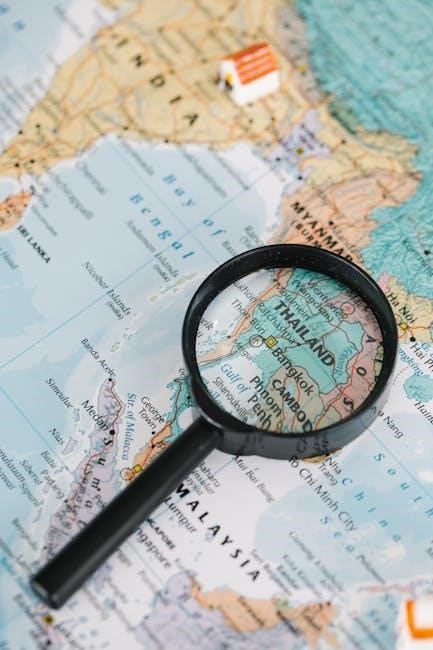This guide provides a comprehensive overview of AP Environmental Science Unit 3, focusing on energy flow, ecosystems, and human impacts. It covers key concepts like trophic levels, ecological pyramids, and conservation biology, helping students prepare for exams and understand environmental systems.
Overview of Key Concepts
This section explores the foundational principles of APES Unit 3, focusing on energy flow, ecosystem interactions, and human influences. Key topics include trophic levels, food chains, ecological pyramids, and the efficiency of energy transfer. It also delves into ecosystem services, carrying capacity, and the role of technology in shaping environmental systems. Conservation biology, biodiversity threats, and climate change impacts are introduced, setting the stage for understanding complex environmental challenges. These concepts are essential for analyzing human-environment interactions and developing sustainable solutions.

Importance of Understanding APES Unit 3
Understanding APES Unit 3 is crucial for grasping how ecosystems function and how human activities impact the environment. This unit provides foundational knowledge about energy flow, ecosystem services, and conservation biology, which are vital for addressing real-world environmental challenges. By studying these concepts, students develop critical thinking skills to analyze human-environment interactions and propose sustainable solutions. Mastery of Unit 3 prepares learners to engage with complex ecological issues, such as climate change and biodiversity loss, and fosters a deeper appreciation for the interconnectedness of natural systems and human societies.

Energy Flow in Ecosystems
Energy flow in ecosystems describes how energy moves through trophic levels, from producers to consumers. It highlights the efficiency of energy transfer and the role of primary production.
Primary Production and Secondary Production
Primary production involves the conversion of sunlight into energy through photosynthesis by plants and algae. Gross primary productivity includes all energy produced, while net primary productivity is the energy available to ecosystems after respiration. Secondary production refers to the energy transferred through consumption, as herbivores eat plants and carnivores consume other animals. This process highlights the efficiency of energy transfer in ecosystems, emphasizing the critical role of producers and the limited energy flow to higher trophic levels due to metabolic losses.
Trophic Levels and Food Chains
Trophic levels categorize organisms by their feeding positions in an ecosystem, forming a hierarchy. Producers, like plants, form the base, converting sunlight into energy. Herbivores, such as insects, are primary consumers, while carnivores, like mice, are secondary consumers. Decomposers, such as fungi, break down organic matter. Food chains illustrate the flow of energy, with each level transferring about 10% of the previous level’s energy. For example, grass → insect → mouse → hawk shows energy moving through trophic levels. This hierarchy is vital for ecosystem balance and biodiversity, demonstrating how energy efficiently flows through ecosystems, supporting life at each stage.
Energy Efficiency and Ecological Pyramids
Energy efficiency in ecosystems is low, with only about 10% of energy transferred between trophic levels. Ecological pyramids—energy, biomass, and numbers—illustrate this hierarchy. Energy pyramids always have a broad base, as producers capture the most energy. Biomass pyramids show the total mass of organisms at each level, while number pyramids represent population sizes. These pyramids highlight the inefficiency of energy flow, explaining why top predators are fewer and why ecosystems rely on constant energy input. Understanding these concepts is crucial for analyzing how energy sustains life and shapes ecosystem dynamics and biodiversity.

Ecosystem Services and Human Impact
Ecosystem services include provisioning, regulating, supporting, and cultural benefits. Human activities disrupt these services, causing ecological imbalances, reduced biodiversity, and long-term environmental degradation.
Supporting, Provisioning, Regulating, and Cultural Services
Ecosystem services are categorized into four types: supporting, provisioning, regulating, and cultural. Supporting services, like nutrient cycling, enable ecosystems to function. Provisioning services provide resources such as food, water, and timber. Regulating services maintain environmental balance, including climate regulation and water purification. Cultural services offer recreational, spiritual, and educational benefits. These services are interconnected and essential for human well-being, illustrating the critical role ecosystems play in sustaining life and livelihoods. Understanding these services highlights the importance of conservation and sustainable management of natural resources.
Carrying Capacity and Human Population Growth
Carrying capacity refers to the maximum population an environment can sustain indefinitely. For humans, it depends on resource availability, technology, and consumption patterns. As the global population grows, it strains resources like food, water, and energy. While technology can temporarily increase carrying capacity, it doesn’t resolve underlying issues of overconsumption and inequality. Understanding these dynamics is crucial for addressing sustainability challenges. Managing population growth through education, family planning, and policy changes can help align human needs with ecological limits, ensuring a more balanced and sustainable future for all. This concept underscores the importance of responsible resource management and environmental stewardship.
Technology and Its Role in Shaping Ecosystems

Technology significantly influences ecosystems by altering natural processes and human interactions with the environment. Advances in renewable energy and conservation tools promote sustainability, while industrial technologies often disrupt habitats. For example, monitoring systems track biodiversity, aiding conservation efforts, but pollution from tech production harms ecosystems.Balancing innovation with ecological preservation is critical to mitigate negative impacts and ensure technologies support environmental health. Understanding this duality is essential for sustainable development, emphasizing the need for responsible technological advancements that align with ecological principles and promote long-term environmental balance.

Conservation Biology
Conservation Biology focuses on preserving biodiversity, preventing extinctions, and restoring habitats. It addresses ethical considerations and human impacts on ecosystems, guiding sustainable practices to protect species and environments effectively.
Threats to Biodiversity and Extinction Risks
Threats to biodiversity include habitat destruction, climate change, pollution, invasive species, and overexploitation of resources. These factors drive species extinction, disrupt ecosystems, and reduce genetic diversity. Human activities, such as deforestation and emissions, exacerbate these risks. Conservation efforts must address these threats to protect vulnerable species and maintain ecological balance, ensuring the survival of diverse life forms and the health of ecosystems. Understanding these risks is critical for developing effective strategies to mitigate extinction and preserve biodiversity for future generations.
Protected Areas and Habitat Restoration
Protected areas, such as national parks and wildlife reserves, play a crucial role in preserving biodiversity by providing safe habitats for endangered species. Habitat restoration involves rehabilitating degraded ecosystems, like reforestation or wetland reconstruction, to support native species and improve ecosystem functionality. These efforts help mitigate biodiversity loss, enhance ecosystem services, and promote ecological balance. However, challenges such as funding limitations and human encroachment often hinder these initiatives. Effective management and community involvement are essential to ensure the success of protected areas and restoration projects, safeguarding biodiversity for future generations.
Ethical Considerations in Conservation Efforts
Ethical dilemmas often arise in conservation, balancing human needs with species preservation. For instance, protecting endangered species may conflict with local livelihoods or resource use. Ethical frameworks guide decisions, ensuring fairness and equity in conservation practices. Transparency and community involvement are crucial to address such challenges effectively.

Climate Change and Its Effects
Climate change drives global warming, altering ecosystems, melting ice caps, and raising sea levels, threatening biodiversity and forcing species migration due to anthropogenic activities.
Greenhouse Gases and Global Warming
Greenhouse gases, such as carbon dioxide, methane, and nitrous oxide, trap heat in the atmosphere, driving global warming. Human activities like fossil fuel combustion, deforestation, and agriculture intensify these emissions. Rising temperatures lead to melting ice caps, sea-level rise, and extreme weather events. Understanding these gases is critical for addressing climate change in APES Unit 3, as they directly impact ecosystems and biodiversity. Mitigation strategies, such as reducing emissions and renewable energy adoption, are essential to curb global warming’s devastating effects.
Impact on Ecosystems and Species Migration
Climate change significantly alters ecosystems, causing species to migrate poleward or to higher elevations in search of suitable habitats. Rising temperatures disrupt food chains, leading to population declines and ecosystem imbalances. Polar bears, for example, face habitat loss as sea ice melts. Coral reefs bleach due to ocean warming, affecting marine biodiversity. These changes threaten ecosystem services, highlighting the need for conservation efforts to protect vulnerable species and maintain ecological balance. Understanding these impacts is crucial for developing strategies to mitigate climate change effects on global ecosystems.
Strategies for Mitigation and Adaptation
Strategies for mitigating climate change include reducing greenhouse gas emissions through renewable energy adoption and carbon capture technologies. Reforestation and afforestation efforts help sequester carbon dioxide. Adaptation strategies involve enhancing ecosystem resilience, promoting climate-resilient agriculture, and protecting natural habitats. Communities can adapt by implementing early warning systems for extreme weather events and investing in infrastructure to withstand rising sea levels. These approaches aim to minimize the impacts of climate change on ecosystems and human societies, fostering sustainability and resilience in the face of ongoing environmental challenges.
The APES Unit 3 study guide concludes with a comprehensive understanding of energy flow, ecosystem services, conservation, and climate change impacts. It emphasizes the importance of sustainable practices and human stewardship of natural resources. By mastering these concepts, students gain insights into balancing environmental health with human needs. This knowledge equips them to address global challenges proactively, fostering a deeper appreciation for ecological systems and their roles within them. The guide serves as a foundation for further exploration and application of environmental science principles in real-world scenarios.



